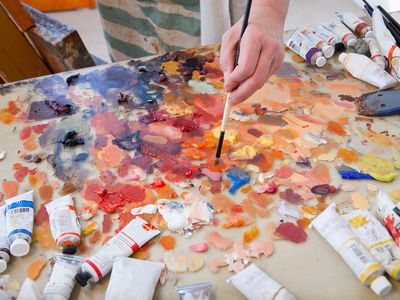
When you have decided, you would like to paint, you may encounter the myth that it takes talent. Don’t believe it. The desire to learn to paint coupled with enthusiasm is what you need more than anything else. You can even learn to paint without being able to draw realistically.
Deciding Which Paint to Use
The first step is deciding what paint you are going to use. The four main choices are oils (traditional or water-soluble), watercolours, acrylics, and pastels. It is a very personal choice: If one type of paint doesn’t suit you, be sure to try another.
Oil Paint is a traditional artist’s medium. It is pigment mixed with such oils as linseed, safflower, or poppy, and thinned with turpentine. It should be used on supports that have been primed with gesso to protect the surface—which can even include paper — from the acid in the oil. Oil paint is slow-drying, so the paint can stay wet on the palette and workable on the painting for many days, making it easy to blend. Clean-up requires solvents such as turpentine or mineral spirits. Water soluble oils have been introduced in recent years, requiring only water to thin the paints and clean the brushes.

Watercolour paint is another traditional medium and uses pigment mixed with a binder made of gum arabic and additives to improve solubility and flow. It is water-soluble, transparent, and comes in a tube, pan, and liquid form. Water Colour paint can be reactivated with water when dry and reworked, even years after you finish your painting. The characteristics of watercolour—its convenience, portability, and easy clean-up — make it a very popular medium for both finished works as well as sketchbooks and visual journals.
Acrylic paint is a more modern choice—it only recently became commercially available for artists in the 1950s. In acrylic paints, the pigment is suspended in a plastic polymer. It’s most notable for its quick drying time and can be used on almost any surface without priming. It’s water-soluble, making cleaning up much easier (all you’ll need are soap and water). Acrylic dries into a durable, flexible, water-resistant surface. It is very versatile and can be used thinly like watercolours or more thickly like oil paints, depending on the desired effect.
As a budding pastel painter, you will likely develop your own preferred brands, but until then, a few stand out or at least are worth a try. John Hersey’s handmade Unison pastels are perfect for beginners. With almost 400 different pastels—sold individually or as colour-coordinated sets—you can add colours as you need them. Schmincke makes the most beautifully soft pastels available: With an almost buttery texture, they glide onto the surface of the paper, even over already heavily worked areas. Rembrandt soft pastels are excellent for line work and early layering in of colour: These are probably the best pastels for starting a painting.

Learning to Mix Colours
Beginners often shy away from colour and colour mixing (especially when it’s labelled “colour theory”), but the basics of colour aren’t particularly complicated. Colour and pigment provide so many different painting possibilities and nuances that an artist could spend a lifetime exploring colour, colour theory, and colour mixing. Indeed, colour mixing is something that often overwhelms beginners because it can be complicated, but colour mixing can also be pared down to some fundamental tips.
So, embrace the challenge, learn, and soon you’ll be mixing just the right tints, tones, and shades. And, if you don’t want to waste the paint by throwing it away, use it with some white to do a monochrome painting or value exercise. Value is another term for tone, which refers to how light or dark the colours are. A value exercise, then, involves working to create lighter or darker tones in your painting.
The Steps in Creating Your Painting
The steps in the creation of a painting vary from artist to artist and develop over time. Many artists lightly sketch out the composition on a canvas, then block in the main areas of colour across the canvas. You can start with the larger shapes and work toward the smaller ones, gradually working on the detail. Some artists work in layers and others work alla prima (all at once) to complete their painting in a single session. Artists often do studies (small versions) or multiple sketches for a painting. There is no right or wrong approach; ultimately you must find what works best for you.
Finding Ideas for Paintings
Some days you will have more ideas than you can get down; others you may find yourself hunting around for inspiration. This is why a creativity journal can be very useful. And don’t despair if you make a “mistake” in your painting: Those can be what artists call “happy accidents,” resulting in something beautiful. If you’re still struggling to come up with concepts, take an enjoyable hour or two to scan the top books for painting ideas and inspiration.
Safety Tips
The No. 1 rule regarding safety and art materials should be obvious—sloppy work habits can be dangerous. Avoid eating a sandwich with paint on your hands, for example. Know what you’re using and what precautions you need or want to take, and where to find nontoxic art materials.








